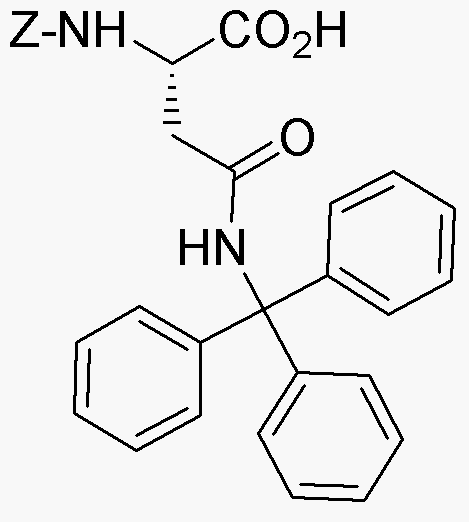Na-Z-Ng-trityl-L-asparagine is widely utilized in research focused on:
- Peptide Synthesis: This compound serves as a key building block in the synthesis of peptides, enabling researchers to create complex molecules for drug development.
- Biotechnology: It is used in the production of recombinant proteins, enhancing the yield and purity of desired proteins in various biotechnological applications.
- Pharmaceutical Research: The compound plays a role in drug formulation, particularly in the design of therapeutics targeting specific biological pathways.
- Analytical Chemistry: It is employed as a standard in chromatographic techniques, aiding in the accurate quantification of amino acids and peptides in complex mixtures.
- Academic Research: Researchers utilize it in studies of protein interactions and enzyme activity, contributing to a deeper understanding of biochemical processes.
General Information
Properties
Safety and Regulations
Applications
Na-Z-Ng-trityl-L-asparagine is widely utilized in research focused on:
- Peptide Synthesis: This compound serves as a key building block in the synthesis of peptides, enabling researchers to create complex molecules for drug development.
- Biotechnology: It is used in the production of recombinant proteins, enhancing the yield and purity of desired proteins in various biotechnological applications.
- Pharmaceutical Research: The compound plays a role in drug formulation, particularly in the design of therapeutics targeting specific biological pathways.
- Analytical Chemistry: It is employed as a standard in chromatographic techniques, aiding in the accurate quantification of amino acids and peptides in complex mixtures.
- Academic Research: Researchers utilize it in studies of protein interactions and enzyme activity, contributing to a deeper understanding of biochemical processes.
Documents
Safety Data Sheets (SDS)
The SDS provides comprehensive safety information on handling, storage, and disposal of the product.
Product Specification (PS)
The PS provides a comprehensive breakdown of the product’s properties, including chemical composition, physical state, purity, and storage requirements. It also details acceptable quality ranges and the product's intended applications.
Certificates of Analysis (COA)
Search for Certificates of Analysis (COA) by entering the products Lot Number. Lot and Batch Numbers can be found on a product’s label following the words ‘Lot’ or ‘Batch’.
*Catalog Number
*Lot Number
Certificates Of Origin (COO)
This COO confirms the country where the product was manufactured, and also details the materials and components used in it and whether it is derived from natural, synthetic, or other specific sources. This certificate may be required for customs, trade, and regulatory compliance.
*Catalog Number
*Lot Number
Safety Data Sheets (SDS)
The SDS provides comprehensive safety information on handling, storage, and disposal of the product.
DownloadProduct Specification (PS)
The PS provides a comprehensive breakdown of the product’s properties, including chemical composition, physical state, purity, and storage requirements. It also details acceptable quality ranges and the product's intended applications.
DownloadCertificates of Analysis (COA)
Search for Certificates of Analysis (COA) by entering the products Lot Number. Lot and Batch Numbers can be found on a product’s label following the words ‘Lot’ or ‘Batch’.
*Catalog Number
*Lot Number
Certificates Of Origin (COO)
This COO confirms the country where the product was manufactured, and also details the materials and components used in it and whether it is derived from natural, synthetic, or other specific sources. This certificate may be required for customs, trade, and regulatory compliance.


